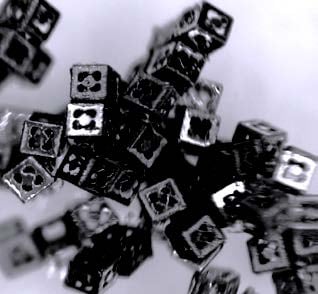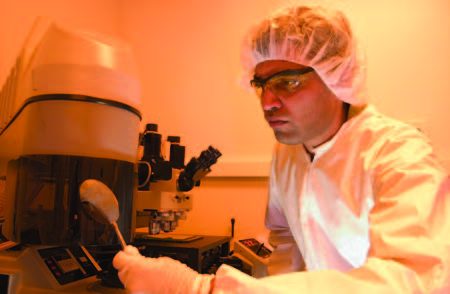David H. Gracias fabricates metal microcontainers that one day could deliver drug therapies or relay health information from inside the body.

MEDICATIONS CAN ENTER the human body in many ways. In liquid form, they can be injected into the bloodstream. As a tablet or capsule, they can be swallowed. In tiny particle form, they can be inhaled into the nose. Yet another type of medicine mover is on the horizon. David H. Gracias wants to put therapeutic drugs or helpful cells inside a box. A metal box, no larger than a dust speck. A self-assembling box constructed from a pattern of flat squares. A box that can be tracked by physicians who want to make sure it’s going where it will do the most good. A box that might even be controlled by a radio transmitter outside the body, allowing it to release its treatment precisely when and where it’s needed. A box that’s relatively inexpensive to mass-produce.
The project may sound like science fiction, but Gracias, who is an assistant professor in the Whiting School of Engineering’s Department of Chemical and Biomolecular Engineering, is off to a promising start. Last December, his research team published a paper in the journal Biomedical Microdevices, detailing how team members had constructed the tiny cubes and how they had, in a lab, successfully dispensed some microbeads and live cells commonly used in medical treatment. The researchers also reported that they could locate the cubes inside a closed tube using magnetic resonance imaging (MRI), a common hospital technology.
The journal article stirred international attention for Gracias, who fabricates the microcubes in his laboratory on the Homewood campus. The article also represented the fruit of his collaboration with the Johns Hopkins School of Medicine’s In Vivo Cellular and Molecular Imaging Center, where post-doctoral fellow Barjor Gimi (lead author on the paper) and colleagues tracked the tiny metal boxes with MRI equipment. The paper generated excitement among researchers elsewhere at Hopkins and at other universities, including one team that believes the microcubes might provide a new way to deliver neurotransmitters to the brain.
Gracias’ project also caught the eye of a few venture capitalists who said they may consider funding further research and development in the technology if it continues to advance.
In March, the Arnold and Mabel Beckman Foundation awarded Gracias a three-year grant totaling $264,000 to support his research on microcubes. As a 2006 Beckman Young Investigator, he will present at an August symposium in Irvine, California, at the Arnold and Mabel Beckman Center of the National Academies.
If the microcubes, perhaps equipped with tiny electronic components, prove to be a safe and effective new way to deliver therapy into the body, Gracias envisions important real-world medical applications. He imagines diabetics who could signal microcubes in their body to release drugs to control blood sugar. Perhaps, he suggests, a person with epilepsy could direct the cubes to release crucial medication at the first hint of a seizure. Although he is not a physician, Gracias wonders if the microcubes might someday be used to deliver remedies directly to cancer cells or to a dangerous blood clot.
“We’re talking about an entirely new encapsulation and delivery device that could lead to a new generation of ‘smart pills,’ ” Gracias says. “The long-term goal is to be able to implant a collection of these therapeutic containers directly at the site of an injury or an illness. What we’ve done so far is a good first step, but it’s early. We still have a lot of work to do.” In the months ahead, the researchers must demonstrate that the metal cubes will not harm living cells over an extended period. Then, they must successfully test the cubes in lab animals. Trials involving human subjects could begin after that.
Gracias, who was born in Bombay, India, earned his doctorate at the University of California at Berkeley. He began working on the self-assembling microcubes while a post-doctoral fellow at Harvard University in the laboratory of George M. Whitesides. Later, he worked as an engineer for the Intel Corporation, developing new processes for fabricating microchips. In 2003, Gracias joined the Whiting School’s faculty to focus his research on constructing micro- and nanosystems with medical applications.

— David H. Gracias
Precision Hinges That Melt
To produce the self-assembling microcubes, Gracias borrowed some of the same techniques used to make microelectronic circuits: thin film deposition, photolithography, and electrodeposition. With these methods, he and his colleagues make a flat pattern of six squares in a shape resembling a cross. Each square, made of copper or nickel, has small pores etched into it. Medications or therapeutic cells eventually could be loaded and released from the cube through the pores.
Along the edges of the adjoining squares, the researchers apply metallic solder to form hinges. These hinges melt when the squares are heated briefly in a lab solution. High surface tension in the liquefied solder pulls each pair of adjoining squares together like a swinging door. The result is a perforated cube. Cooling the solution causes the solder to harden again, and the containers retain their box-like shape.
“To make sure it folds itself exactly into a cube, we have to engineer the hinges very precisely,” Gracias says. “The self-assembly technique allows us to make a large number of these microcontainers at the same time and at a relatively low cost.”
The hope is that these microcubes someday can be injected into targeted body tissue, not into the bloodstream. In theory, medical personnel could use magnetic forces to move the metal boxes to a particular location once the boxes are in the body. Gracias and his colleagues have not yet demonstrated that this type of magnetic manipulation in the body would work, but they remain confident. They have, however, built microcubes that can release their contents in response to a radio signal.
How Safe Are They?
As their research proceeds, one early hurdle is determining whether the metallic microcubes pose any toxic threats to living tissue. During the fabrication process, each cube receives a thin coating of gold, an inert metal that generally poses no toxicity problems in humans. But the researchers need to make sure this protective coating will last and that the cubes will trigger no dangerous reactions within the body.
These initial toxicity tests are under way in Gracias’ Homewood lab. Animal testing is expected to follow at another location. In the early experiments involving MRI tracking, Gracias collaborated with radiology researchers at the Johns Hopkins School of Medicine. He hopes to partner with other researchers there to conduct the animal testing, which is beyond his area of expertise. The Whiting School’s close ties with the School of Medicine are important, he emphasizes. “We’ll need their help for the in vivo testing and more MRI tracking,” he says.
Gracias also is working with the University’s technology transfer staff, which has filed for a provisional patent covering the self-assembling microcontainer technology.
Bio-beeps from the Body
Although drug delivery applications have received the most attention, Gracias believes the microcubes have other potential uses. If their ability to house radio components is developed, the cubes may be able to function as bio-sensors, relaying important health information from inside the body without the need for major surgery.
Another interesting prospect, Gracias says, is the placement of two different compounds in separate microcubes. When the cubes reach the right location, the contents could be released simultaneously and interact to create a chemical reaction in a tightly confined site. “This could have implications not just in medicine, where some drugs need to be mixed just before they are used, but also in chemistry,” he notes, referring to new nanofluidic technology, in which liquid flows through tiny maze-like channels on a chip.
For Gracias, the future is wide open. “Our self-assembling cubes,” he says, “have generated a lot of excitement.”
To learn more, visit engineering.jhu.edu/chbe/faculty/gracias/g/.




